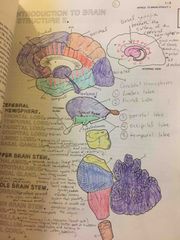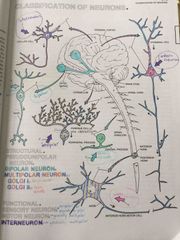![]()
![]()
![]()
Use LEFT and RIGHT arrow keys to navigate between flashcards;
Use UP and DOWN arrow keys to flip the card;
H to show hint;
A reads text to speech;
23 Cards in this Set
- Front
- Back

Front (Term) |

Pic |
|
|
Basal ganglia |
Beneath surface of then hemispheres are great masses of fibers conducting impulses in all directions, and large groups of cells forming discrete bodies at the base of each hemisphere. Major role is in programming and execution of movement (motor activity). Diseases are manifested by trembling and uncontrolled movements |
|
|
Upper brain stem |
Thalamus, hypothalamus, pineal gland |
|
|
Middle brain stem |
Midbrain (reflexes associated with vision and auditory systems, and other movement patterns) |
|
|
Lower brain stem |
Pons , medulla oblongata, cerebellum, spinal cord |
|
|
Thalamus |
Sensory gateway (except smell) to the cerebral hemispheres |
|
|
Hypothalamus |
Regulates appetite, thirst, body temp, controls hormonal secretions from pituitary gland and thereby many endocrine glands, controls visceral nervous system which stimulates contraction of muscles and glandular secretion of the internal organs |
|
|
Pineal gland |
Biological clock; regulates sexual activity and body rhythms |
|
|
Pons |
Relay between cerebral hemispheres and cerebellum |
|
|
Cerebellum |
Muscle coordination and balance, as in writing and walking |
|
|
Medulla oblongata |
The medulla Vital functions like respiration and heart rate; continuous with spinal cord; lowest part of the hindbrain |
|
|
Structure of the neuron |
Neuron: cell membrane, nucleus (aka karyon), nuclear membrane, nucleoplasm, nucleolus Cytoplasm: mitochondria, endoplasmic reticulum, Golgi body, microtubule, neurofilament |
|
|
Tracts |
The long fibers or axons or neurons are often grouped. In the CNS, bundles of axons carrying information or motor commands of one kind are called tracts. Tracts make up the white matter of the CNS. In the PNS, discrete bundles of axons bringing information to the CNS from peripheral structures and conducting motor commands to muscles and glands are called nerves. |
|
|
Nucleus (nuclei) Ganglion (ganglia) |
Groups of unencapsulated neuronal cell bodies in the CNS are called nuclei. In the PNS, such groups, usually encapsulated, are called ganglia. In the CNS, masses of neuronal cell bodies largely contribute to the grey matter of the brain and spinal cord. |
|
|
Apolar/unipolar neuron |
No processes, or only one : are seen in embryonic neural tissue. |
|
|
Psuedounipolar Neuron |
Neuron with 2 fused processes that appear as one, and are generally restricted to groups of sensory neuron cell bodies located outside the CNS. The short, single branch splits into a central process conducting impulses toward the spinal cord, and a peripheral process conducting impulses toward the cell body. Sensory neurons are typically bipolar or pseudounipolar. |
|
|
Bipolar Neurons |
Limited to 2 processes, usually one dendrite and one axon, occasionally 2 dendrites. Found in selected areas such as the ganglia of the VIII cranial nerve, the retina, and the olfactory epithelium (receptor cells in the roof of the nasal cavity) Sensory neurons are typically bipolar or pseudounipolar. |
|
|
Multipolar Neurons |
One axon and two or more dendrites. The most common type in the nervous system. Golgi I: long axon multipolar, found throughout the nervous system. Ex: pyramidal cell of cerebral cortex, Purkinje cell of the cerebellum, and anterior horn cell of the spinal cord. Golgi II: short axon multipolar, typified by the stellar or granule cells of the cerebral cortex |
|
|
Sensory Neurons |
The sensory (afferent) components of brain and spinal cord. Carry impulses from receptors TO brain and spinal cord (vision, touch, pain, sound, etc). Typically pseudounipolar or bipolar |
|
|
Motor Neurons |
Conduct impulses FROM brain and spinal cord to effectors (muscles and glands), resulting in contraction of muscle fibers or secretion of gland cells. Are the motor (efferent) component of the spinal and cranial nerves. Aka Lower Motor Neurons. Are generally multipolar. |
|
|
Interneurons |
Neurons whose cell bodies and processes remain within the CNS. Have no direct contact with peripheral structures (receptors and effectors). One important group of interneurons is called Upper Motor Neurons. Responsible for the coordination, modification, integration, facilitation, and inhibition that must occur between sensory input and motor output. They are the source of the seemingly unlimited array of responses to our environment. Generally multipolar. |
|

Front (Term) |
Pic |
|

Front (Term) |
Picture |

